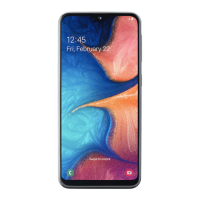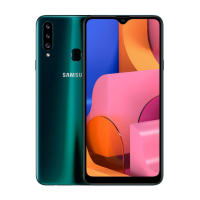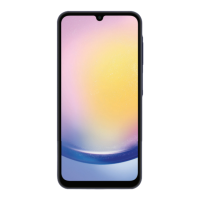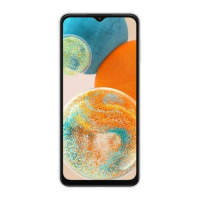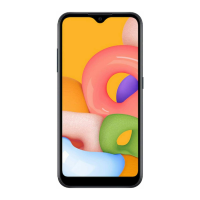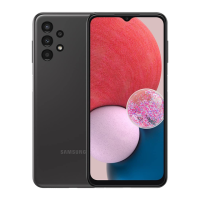Do you have a question about the Samsung Galaxy A21S and is the answer not in the manual?
Essential safety information and usage guidelines before operating the device.
Explains physical components, installation of SIM/memory cards, and key functions.
Guides on device startup, basic screen controls, gestures, and navigation methods.
Details on battery care, charging methods, and optimizing power usage for extended life.
Instructions for migrating data and using the on-screen keyboard for text entry.
How to download, manage, and set permissions for applications on your device.
Guides on making calls, managing contacts, sending/receiving messages, and blocking numbers.
Browsing the web, using secret mode, viewing and managing photos and videos.
Using apps for scheduling, notes, timing, calculations, and listening to the radio.
Enhancing gaming performance and managing games for a better experience.
Configuring wireless networks, device pairing, and data sharing options.
Customizing audio alerts, screen appearance, brightness, and notification settings.
Setting up screen locks, using face and fingerprint recognition for secure access.
Managing personal data, location services, syncing accounts, and cloud backup options.
Optimizing performance, managing memory, system settings, accessibility, and updates.
Solutions for common device errors, connectivity problems, and network service issues.
Steps to fix device freezing, slow performance, and unresponsive touchscreen problems.
Diagnosing and resolving problems related to calls, audio quality, and battery performance.
Troubleshooting camera errors, poor photo quality, and Bluetooth connection malfunctions.
Information on physical aspects, storage management, and safe battery handling.
| Panel type | PLS |
|---|---|
| Screen shape | Flat |
| Pixel density | 270 ppi |
| Display diagonal | 6.5 \ |
| Touchscreen type | Capacitive |
| Display resolution | 720 x 1600 pixels |
| Native aspect ratio | 20:9 |
| Display number of colors | 16 million colors |
| Processor cores | 4 |
| Processor family | Samsung Exynos |
| Processor frequency | 2 GHz |
| Processor architecture | ARM Cortex-A55 |
| User memory | 19.5 GB |
| RAM capacity | 3 GB |
| Compatible memory cards | MicroSD (TransFlash) |
| Maximum memory card size | 512 GB |
| Internal storage capacity | 32 GB |
| Flash type | LED |
| Rear camera type | Quad camera |
| Front camera type | Single camera |
| Maximum frame rate | 30 fps |
| Video recording modes | 1080p |
| Rear camera aperture number | 2 |
| Resolution at capture speed | 1920x1080@30fps |
| Video capture resolution (max) | 1920 x 1080 pixels |
| Rear camera resolution (numeric) | 48 MP |
| Front camera resolution (numeric) | 13 MP |
| Third rear camera aperture number | 2.4 |
| Second rear camera aperture number | 2.2 |
| Third rear camera resolution (numeric) | 2 MP |
| Second rear camera resolution (numeric) | 8 MP |
| 4G standard | LTE-TDD & LTE-FDD |
| 3G standards | UMTS |
| SIM card type | NanoSIM |
| Wi-Fi standards | 802.11a, 802.11b, 802.11g, Wi-Fi 4 (802.11n), Wi-Fi 5 (802.11ac) |
| Bluetooth version | 5.0 |
| 3G bands supported | 850, 900, 1900, 2100 MHz |
| 4G bands supported | 700, 800, 850, 900, 1800, 1900, 2100, 2300, 2500, 2600 MHz |
| SIM card capability | Dual SIM |
| Mobile network generation | 4G |
| Subscription type | No subscription |
| USB version | 2.0 |
| ANT+ enabled | No |
| USB connector type | USB Type-C |
| Headphone connectivity | 3.5 mm |
| Form factor | Bar |
| Product color | White |
| Wireless charging | - |
| Audio formats supported | 3GA, AAC, AMR, AWB, FLAC, IMY, M4A, MID, MIDI, MP3, MXMF, OGA, OGG, OTA, RTTTL, RTX, WAV, WMA, XMF |
| Video formats supported | 3G2, 3GP, ASF, AVI, FLV, M4V, MKV, MP4, WEBM, WMV |
| Platform | Android |
| Virtual assistant | Samsung Bixby |
| Google applications | Google Maps, Google Play |
| App distribution platform | Google Play |
| Operating system installed | Android 10.0 |
| Talk time (3G) | - h |
| Battery capacity | 5000 mAh |
| Browsing time (Wi-Fi) | 23 h |
| Continuous audio playback time | 109 h |
| Multimedia Messaging Service (MMS) | Multimedia Messaging Service (MMS) is a standard way to send messages that include multimedia content to and from a mobile phone over a cellular network |
| Body SAR (EU) | 1.544 W/kg |
| Head SAR (EU) | 0.422 W/kg |
| Extremities SAR (EU) | 2.21 W/kg |
| Repairability index | 8 |
| Depth | 8.9 mm |
|---|---|
| Width | 75.3 mm |
| Height | 163.7 mm |
| Weight | 192 g |



